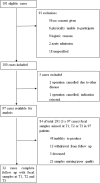Marked Changes in Gut Microbiota in Cardio-Surgical Intensive Care Patients: A Longitudinal Cohort Study
- PMID: 32010644
- PMCID: PMC6974539
- DOI: 10.3389/fcimb.2019.00467
Marked Changes in Gut Microbiota in Cardio-Surgical Intensive Care Patients: A Longitudinal Cohort Study
Abstract
Background: Virtually no studies on the dynamics of the intestinal microbiota in patients admitted to the intensive care unit (ICU) are published, despite the increasingly recognized important role of microbiota on human physiology. Critical care patients undergo treatments that are known to influence the microbiota. However, dynamics and extent of such changes are not yet fully understood. To address this topic, we analyzed the microbiota before, during and after planned major cardio surgery that, for the first time, allowed us to follow the microbial dynamics of critical care patients. In this prospective, observational, longitudinal, single center study, we analyzed the fecal microbiota using 16S rRNA gene sequencing. Results: Samples of 97 patients admitted between April 2015 and November 2016 were included. In 32 patients, data of all three time points (before, during and after admission) were available for analysis. We found a large intra-individual variation in composition of gut microbiota. During admission, a significant change in microbial composition occurred in most patients, with a significant increase in pathobionts combined with a decrease in strictly anaerobic gut bacteria, typically beneficial for health. A lower bacterial diversity during admission was associated with longer hospitalization. In most patients analyzed at all three time points, the change in microbiota during hospital stay reverted to the original composition post-discharge. Conclusions: Our study shows that, even with a short ICU stay, patients present a significant change in microbial composition shortly after admission. The unique longitudinal setup of this study displayed a restoration of the microbiota in most patients to baseline composition post-discharge, which demonstrated its great restorative capacity. A relative decrease in benign or even beneficial bacteria and increase of pathobionts shifts the microbial balance in the gut, which could have clinical relevance. In future studies, the microbiota of ICU patients should be considered a good target for optimisation.
Keywords: 16S rRNA gene sequencing; critically ill; gut microbiota; intensive care unit; intestinal microbiota; longitudinal study.
Copyright © 2020 Aardema, Lisotto, Kurilshikov, Diepeveen, Friedrich, Sinha, de Smet and Harmsen.
Figures





Similar articles
-
Comparative gut microbiota and resistome profiling of intensive care patients receiving selective digestive tract decontamination and healthy subjects.Microbiome. 2017 Aug 14;5(1):88. doi: 10.1186/s40168-017-0309-z. Microbiome. 2017. PMID: 28803549 Free PMC article.
-
Dysbiosis of the intestinal microbiota in neurocritically ill patients and the risk for death.Crit Care. 2019 May 31;23(1):195. doi: 10.1186/s13054-019-2488-4. Crit Care. 2019. PMID: 31151471 Free PMC article.
-
Lung and gut microbiota profiling in intensive care unit patients: a prospective pilot study.BMC Infect Dis. 2025 Apr 5;25(1):468. doi: 10.1186/s12879-025-10825-6. BMC Infect Dis. 2025. PMID: 40188054 Free PMC article.
-
Microbiome in Critical Care: An Unconventional and Unknown Ally.Curr Med Chem. 2022;29(18):3179-3188. doi: 10.2174/0929867328666210915115056. Curr Med Chem. 2022. PMID: 34525908 Review.
-
Should fecal microbial transplantation be used in the ICU?Curr Opin Crit Care. 2018 Apr;24(2):105-111. doi: 10.1097/MCC.0000000000000489. Curr Opin Crit Care. 2018. PMID: 29432297 Review.
Cited by
-
Pain in the Cancer Survivor.Cancer Treat Res. 2021;182:57-84. doi: 10.1007/978-3-030-81526-4_5. Cancer Treat Res. 2021. PMID: 34542876
-
Provision of Microbiology, Infection Services and Antimicrobial Stewardship in Intensive Care: A Survey across the Critical Care Networks in England and Wales.Antibiotics (Basel). 2023 Apr 17;12(4):768. doi: 10.3390/antibiotics12040768. Antibiotics (Basel). 2023. PMID: 37107130 Free PMC article.
-
Predicting acute lung injury in infants with congenital heart disease after cardiopulmonary bypass by gut microbiota.Front Immunol. 2024 Oct 24;15:1362040. doi: 10.3389/fimmu.2024.1362040. eCollection 2024. Front Immunol. 2024. PMID: 39512354 Free PMC article.
-
Comparative analysis of the postadmission and antemortem oropharyngeal and rectal swab microbiota of ICU patients.Sci Rep. 2024 Nov 8;14(1):27179. doi: 10.1038/s41598-024-78102-1. Sci Rep. 2024. PMID: 39516251 Free PMC article.
-
Secondary Sclerosing Cholangitis in Critically Ill Patients Alters the Gut-Liver Axis: A Case Control Study.Nutrients. 2020 Sep 7;12(9):2728. doi: 10.3390/nu12092728. Nutrients. 2020. PMID: 32906634 Free PMC article.
References
-
- Bartram A. K., Lynch M. D., Stearns J. C., Moreno-Hagelsieb G., Neufeld J. D. (2011). Generation of multimillion-sequence 16S rRNA gene libraries from complex microbial communities by assembling paired-end illumina reads. Appl. Environ. Microbiol.. 77, 3846–3852. 10.1128/AEM.02772-10 - DOI - PMC - PubMed
-
- Buelow E., Bello González T. D., Fuentes S., de Steenhuijsen Piters W. A., Lahti L., Bayjanov J. R., et al. . (2017). Comparative gut microbiota and resistome profiling of intensive care patients receiving selective digestive tract decontamination and healthy subjects. Microbiome 5:88. 10.1186/s40168-017-0309-z - DOI - PMC - PubMed
Publication types
MeSH terms
Substances
LinkOut - more resources
Full Text Sources
Medical
Miscellaneous

